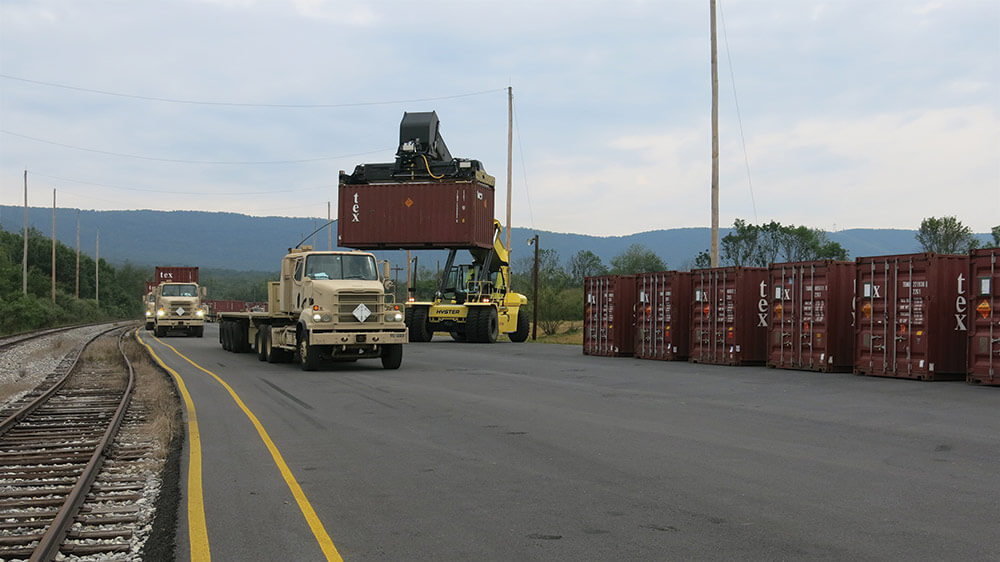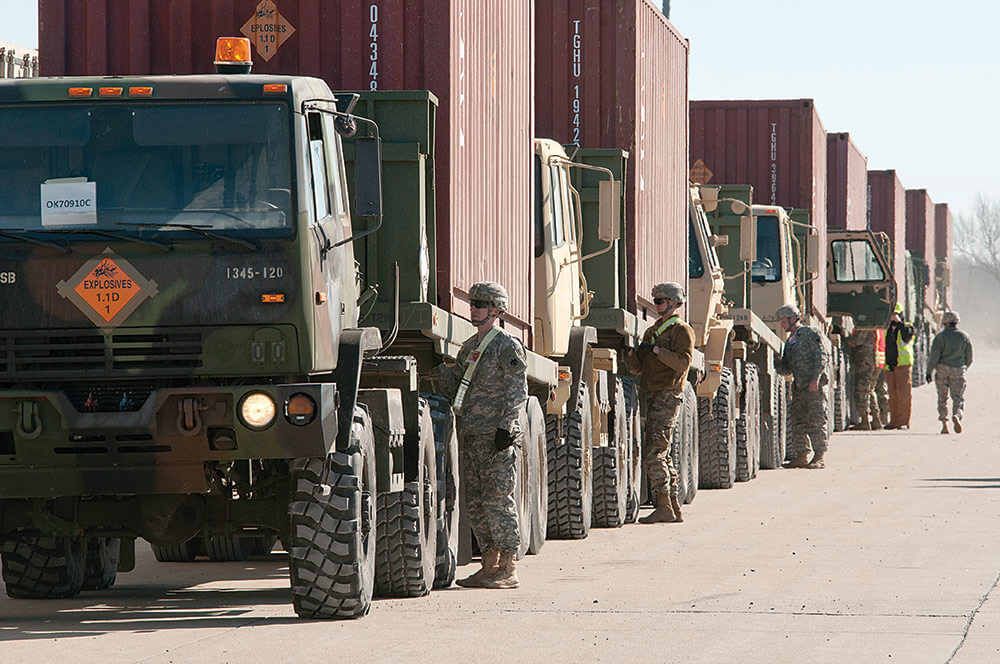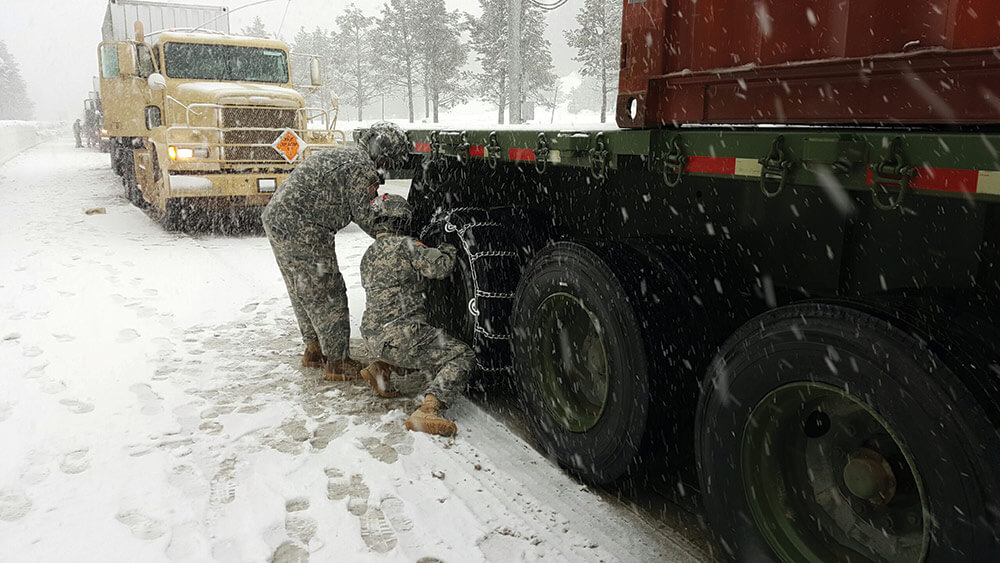ARMY NATIONAL GUARD CONVOYS pounded back and forth across the roads of our Nation’s highways and byways last year. They traveled over 2,000,000 miles, carrying hundreds of containers filled with their precious cargo – the U.S. Army’s war reserve munitions.
The Guard Soldiers operating in these convoys were working in support of Operation Patriot Bandoleer (OPB), an ongoing joint mission that calls on Soldiers from all components of the Army – National Guard, Reserves and active duty.
OPB began in 2015 and is a collaborative initiative between the National Guard Bureau, Army Materiel Command, Army Sustainment Command, Joint Munitions Command, and the Military Surface Deployment and Distribution Command. It involves the movement and life-cycle management of thousands of tons of munitions and war reserve materiel in support of the U.S. Army Sustainment Command (ASC)’s Army Prepositioned Stock (APS).

Military prepositioned stocks consist of warehouses filled with equipment and supplies in strategic locations around the world. Keeping these stocks readily available and poised for use not only deters aggressive behavior by foreign adversaries, but also works to increase mobilization speeds.
In a 2016 interview, Timothy Fore, director, Sustainment Operations and Army Prepositioned Stocks Directorate, said, “Linking Reserve component Soldiers to APS redistribution not only supports the Total Force Development concept of the Army, but [also] gives the Soldiers exposure to real-world mission experiences they will need to support humanitarian assistance and contingency operations in the future.”
OPB is spearheaded by Fore on the ASC side and, on the Guard side by Anthony Skivo, OPB Program Manager and Senior Logistics Analyst for National Guard Bureau.
“When Tim and I got together, [the operation] became much larger and more productive than anything I could have ever thought,” said Skivo.
OPB has become one of the largest multi-component logistics events supporting the APS program.
Missouri Army National Guard BG David Boyle has been an integral part of OPB since its inception in 2015. With Missouri participating each year and taking the lead in OPB 2016, BG Boyle understands firsthand the significance of the operation.
“It’s the ultimate support operation planning and execution exercise short of theater,” he said. “The training benefit we receive is absolutely tremendous. Soldiers can say they are doing an actual mission for the Army. That’s incredible for a Soldier,” noted BG Boyle.
OPB is set up in iterations throughout the year, with each iteration requiring approximately six months to a year of planning.
“It’s basically a miniature deployment,” said CPT Derek Ellyson, commander of the Georgia Army National Guard’s 1148th Transportation Company. “You’ve got all hands on deck. So, think of all the things that go into a deployment and we do that here. When one mission ends, we start planning for the next year, pretty much the very next day. It takes that much planning.”
When planning the operation, ASC first identifies the requirements of that year’s operation. National Guard Bureau then assigns a task force of motor transport operators, maintenance personnel and administrative personnel from Army National Guard transportation units. For each iteration, one State is chosen to lead the task force. Once chosen, the lead State coordinates with other States to help move munitions to a final destination.
As lead planner for OPB on the Army National Guard side, Skivo works in a collaborative effort between Army National Guard Operations and Logistics and the States that have the capacity to partner in OPB – and are standing in the Readiness Cycle – to determine which State will lead the task forces each year.
“We sit down and figure out who has the capacity to lead and execute this,” said Skivo. “They must have the right logistics-type planning headquarters and the right type of transportation unit.”
States that participated in 2017’s operation included Arizona, California, Florida, Georgia, Iowa, Kentucky, Missouri, Nevada, North Carolina, Ohio, Oklahoma and South Carolina. While States participated during different times throughout the year, all units received the benefit of executing a real-world mission.

“OPB utilizes the National Guard Transportation Company at every level, from individual Soldier tasks to company-level command and control,” said CPT Ellyson. “We have the unique opportunity to use our annual training to execute a real-world mission stateside, which directly impacts the Nation’s ability to conduct operations overseas. We are proud to be part of such an important and rewarding mission.”
On Jan. 14, 2017, OPB 2017 commenced with Task Force Golden Patriot. The Task Force was led by the California Army National Guard’s 224th Sustainment Brigade and included Army National Guard units from Arizona, Missouri, Nevada and Oklahoma.
During this first leg of the OPB mission, 732 Soldiers successfully logged 645,000 miles and moved 375 containers of munitions from the Military Ocean Terminal in Concord, Calif., to McAlester Army Ammunition Plant in McAlester, Okla., and Hawthorne Army Depot in Hawthorne, Nev.
“Missions like these allow the Army National Guard to flex our muscle a bit and show what we are able to accomplish,” said 1LT Gabriel McDonald of the Arizona Army National Guard’s 1120th Transportation Battalion. “What we bring to the table is phenomenal. A lot of Soldiers are also commercial truck drivers and they bring that experience of working with our civilian counterparts. Others are in law enforcement and know certain road regulations that have helped with traffic situations. [Those] various pools of talent to draw on are the inherent strength of the Guard.”
The second leg of OPB took place in August of 2017. Army National Guard units from Florida, Georgia, Iowa, Kentucky, North Carolina and Ohio participated as Task Force Hauling Freedom. Led by the South Carolina Army National Guard, the month-long operation included 859 Soldiers collectively driving more than 1,750,000 miles to transport 659 containers of munitions.
“You can’t beat this,” said SGT Michael Davis, a motor transport operator with the Georgia Army National Guard’s 1148th Transportation Company. “I think it’s a pretty cool mission. You get to see different things, different places. It gives some of the younger Soldiers the experience of driving on the open road and handling the various materiel that we’re hauling.”
Task Force Hauling Freedom worked with the Letterkenny Munitions Center (LEMC) in Chambersburg, Pa. The LEMC is a government-owned and -operated installation that conducts regional and global distribution of munitions. It also provides missile maintenance and conducts demilitarization of munitions for Joint Forces and international partner nations.

Upon arrival at LEMC, Soldiers lined their trucks along the road near one of LEMC’s containerization docks, where LEMC employees then worked to unload the containers from the trucks. Once the containers were unloaded, Soldiers continued on their journey, and the LEMC Logistics Operations team worked to inventory and store the items from the containers.
LEMC often partners with the National Guard and the U.S. Army Reserves to foster joint opportunities to develop Soldier, NCO and Officer proficiency.
“Not only are we delivering strategic munitions readiness but, tactically, these units get valuable on-the-job training, ensuring execution readiness on missions overseas if called upon,” said LTC Jeffrey Ignatowski, commander of the LEMC.
“This is real-world stuff,” said COL Larry Vaughn, executive officer for the assistant deputy commanding general for National Guard affairs at Army Materiel Command headquarters. “This is not made up. This is not practice. It’s moving materiel for the Army, driving Army vehicles, [and] doing all of the checks and balances that are required for Army missions.”
Despite the impressive number of miles covered, OPB comes with its own host of challenges each year. Weather often poses a challenge, with Soldiers frequently called upon to conduct line-haul operations in intense weather conditions. Heavy rain, snow storms and black ice are all serious concerns for which Soldiers must plan when traveling with several tons of munitions strapped to the back of a truck. According to COL Julian Bond, brigade commander of the 224th Sustainment Brigade, California Army National Guard, approximately 68 percent of the Soldiers with Task Force Golden Patriot had never operated tactical vehicles in the snow, or used snow chains, before the 2017 operation.
“It gave [Soldiers] an experience that they don’t have very often – with stopping convoys, applying the snow chains to the unit equipment as they went through paths in California that had about six feet of snow during the operation,” said Fore. “It increases unit readiness for what could happen in the near future.”
Along with intense weather conditions, Soldiers experienced long hours, extended driving distances and heavy traffic.
“You have to pay attention to what you’re doing,” said SSG Steven Allen of the 1148th Transportation Company. “You have civilian vehicles out there. Our trucks don’t go as fast and you’ve got people in some vehicles that want to get ahead; and that’s when your accident avoidance comes into play. Sometimes they forget that we can’t stop as fast as they can.”
While OPB requires an immense amount of planning, for this unique mission, Soldiers must be ready for those well-laid plans to change mid-operation.
As part of Task Force Hauling Freedom, Iowa Army National Guard’s 1133rd Transportation Company hauled munitions from ships docking at the Military Ocean Terminal Sunny Point (MOTSU) in Southport, N.C., to the Hawthorne Army Depot in Hawthorne, Nev. SFC Charles Jarvis of the 1133rd recalls how the need to rearrange plans was just a normal part of working in OPB.
“You are working with the point of origin, which comes from Sunny Point,” SFC Jarvis explained. “When a ship comes in, you have to plan everything around that ship. But, [the ships] can have delays. You are planning to be there one day but they could need to reschedule to a different day. There’s a lot of challenges [involved] to get everything changed around logistically in a matter of a week.”
Despite the many challenges, both task forces successfully completed their assigned segment of OPB.
“We put in more than 6,500 miles in an 18-day period. And we drove through 21 States,” SFC Jarvis said. “It was a big accomplishment for the unit to complete the task with no injuries or accidents. Everyone was motivated to complete the mission and they were all satisfied.”
“These folks get really excited to be able to do this,” COL Vaughn remarked. “This is what they are supposed to do. [On a mission], mishaps sometimes happen. Something will break down, you realize your equipment is not as good as you thought, or some people need re-training in skilled driving. But [for Operation Patriot Bandoleer 2017], we heard nothing but good things.”
The hands-on training and real-world challenges OPB provided helped increase the readiness and confidence of the Soldiers involved.
“The real-world mission adds a certain amount of value to our experiences that we just don’t get in training missions,” 1LT McDonald explained. “There’s nothing notional about what we are doing here. There’s a certain amount of weight to it, in both a literal and figurative sense.”
With the continued success of operations, plans are actively in motion for Operation Patriot Bandoleer 2018, and Skivo hopes to continue growing the campaign.
“It’s a great exercise for the drivers, NCOs, company commanders and the headquarters,” said Skivo. “It teaches them how to coordinate across State lines and across component lines. The average unit does not get to deal with Army Materiel Command or Army Sustainment Command – that’s done by their State headquarters. These Soldiers get to see an aspect of the Army and how the Army operates at a level they may never see again in their career. That’s truly what the Chief of Staff of the Army wants to see – multi-component training and the components working together just as they would be if they are deployed.”
By Staff Writer Tatyana White-Jenkins
VIDEO




